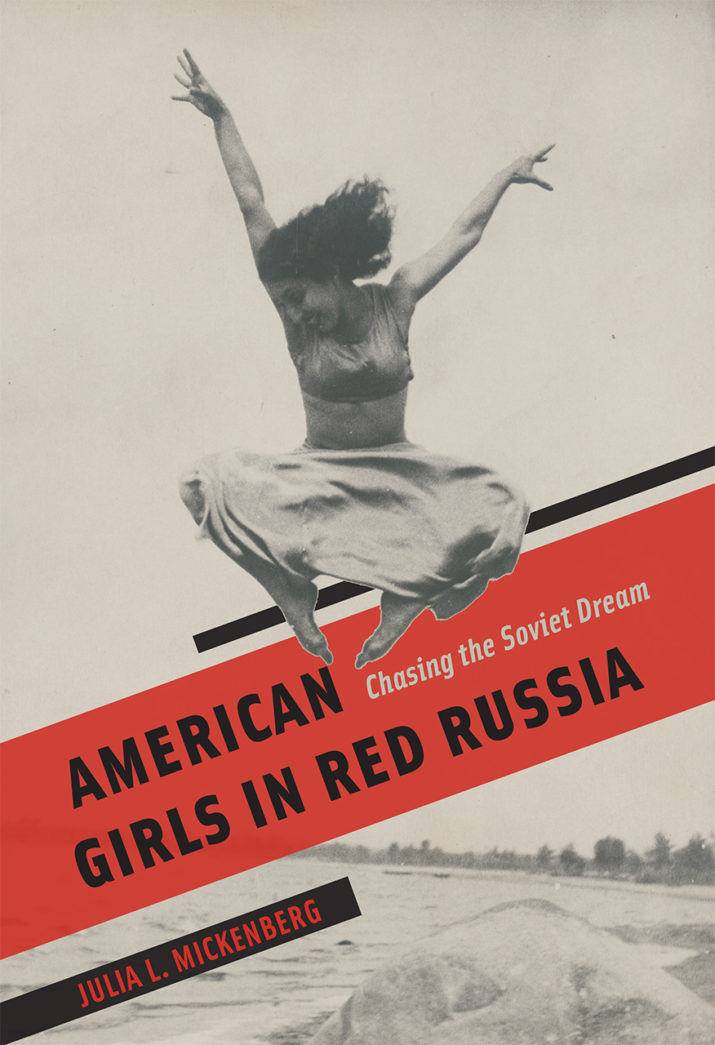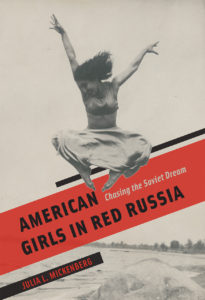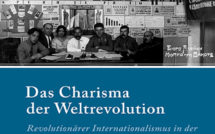
 This is part of our special feature, Diversity, Security, Mobility: Challenges for Eastern Europe.
This is part of our special feature, Diversity, Security, Mobility: Challenges for Eastern Europe.
Julia Mickenberg’s American Girls in Red Russia, touches on such diverse topics as American women’s participation in pre-1917 revolutionary movements, famine relief in during the Civil War period, the creation of an American colony in Siberia, the establishment of an American-run English language newspaper in Moscow, modern dance, African-American theater and film performances, and creating pro-Russian World War II propaganda. These disparate subjects are unified by a central theme: American women, from various cultural spheres, seeking the equality and freedom they thought redefined gender roles in the Soviet Union would give them.
Mickenberg’s book successfully captures the real depth of interest, hope, and fascination that the Soviet Union held for many well educated, left-leaning American women, and how these feelings were colored by the gap between Soviet ideals and realties. She provides a fascinating account of these women’s willingness to uproot their lives in search of careers, sexual liberation, and the ability to participate in the construction of a new communal society, contrasting the opportunities the Soviet Union offered with the limitations these women faced at home.
Indeed, Mickenberg’s greatest triumph is explaining the Soviet Union’s very real appeal to well-educated, left-leaning, career-oriented women. The Bolsheviks had granted women the right to vote before the US, and actively encouraged female political participation through organizations such as zhenotdel.’[1] The Soviets attempted to establish communal dining halls, laundries, and nurseries to free up women from household chores and allow women to enter the workforce. The Soviet Union also promised sexual freedom for women. The most well-known female Bolshevik, Alexsandra Kollantai, pushed the idea of free, comradely love, outside the confines of a bourgeois marriage. In the 1920s, divorce became increasingly easy to obtain and abortion and contraceptives were legalized at a time when even giving women information about birth control was illegal in the US.
From a Soviet perspective, these were usually utilitarian rather than idealistic choices, as labor, particularly skilled labor, was vital to the industrialization and later the collectivization drives across the country, and women contributed greatly to this labor pool. However, these changes appealed to many middle-class, educated, and primarily white American women who saw being a mother as simultaneously the heaviest burden and the greatest joy, and sought to reconcile motherhood and a career. (Her chapter on African-American women does not touch on the burden of being a wage earner and a mother, perhaps because her subjects were not mothers or because it has been a reality of African-American women’s lives for so long that they merely accepted this burden as inescapable). The glamorization of the Soviet professional woman appealed to these women, as they were facing enormous pressures from conservative American society to subordinate their own career desires to their roles as wife and mother. Mickenberg offers a poignant example of these struggles in Ruth Kennell, who left her infant son in California to move with her husband to the Siberian Kusbas’ colony, where she became a secretary and the colony librarian. She began an affair with a Jewish-American worker shortly after her husband returned to the US and was frequently torn between her new, happy, free life in Siberia and ever increasing pressure from her husband and mother-in-law to return to the US and her role as a wife and mother.
Mickenberg’s book is overall exemplary. Her first chapters on the pre-revolutionary period, the women charity workers, the Kuzbas colony, and the female reporters for the English language Moscow News are outstanding. She balances the biographical details of the women involved in these activities with historical context and theoretical analysis. She writes about how the first women to visit the USSR were often active members of abolitionist, suffragist, or settlement house movements, which provided many of these women with formative experience in community organization and social activism. She explains in great detail American women’s interest and involvement in Russia. For example, women raised money to support Narodnik [2] terrorists and organizing speaking tours for them out of admiration for gender equality in their organization and unsympathetic feelings towards the autocracy, which was often propagated by Jewish communities who had suffered horrific violence and oppression in Tsarist Russia. She illustrates how the practical, political, and ideological converged in these women’s lives, writing about women charity workers who had to balance Bolshevik suspicions, Hoover’s anti-communist stance and work with starving children who they wished to save and by whom, as architects of a bright, new, egalitarian future, they wished to be saved. Her analysis of African American actors’ and musicians’ tours and life in the USSR provides a sharp contrast to their treatment in the United States, while outlining the history of African American music, minstrel shows and how, even in the USSR, both men and women were expected to perform their blackness. However, her later chapters on Isadora Duncan, Pauline Koner and, in particular the chapter on Lillian Hellman and Margaret Bourke-White’s pro-Soviet war propaganda, read as short histories of contemporary dance or these women’s stellar careers without much analysis of why these women were drawn to the USSR.
Despite the depth of information she provides on topics such as the American Left, the development of modern dance, and the way African American performances were framed within a prescribed “Southern, Pastoral, Mammy” narrative, even for educated elites, Mickenberg does not provide much context for what is happening in Russia, and later the Soviet Union, as these women are working and living there. She does discuss the 1921 famine in some detail as it provides the all-important context for charity work in Russia, but later milestones such as NEP, collectivization and even Stalinist repression are glossed over, except to say that many of the American women claimed not to know the full extent of the repression. No doubt this is in part because these women were elite and only tangentially at best involved with these changes or with average Russians in general. They traveled with in the circles of the party, intellectual, and cultural elite but even then, Mickenberg does not provide much context which is disappointing, particularly as many of these Russian intellectual and cultural elites, including journalist Milly Bennett’s Russian husband, were either sent to the Gulag or executed in the late 1930s.
Additionally, she never addresses that the women who are attracted to the USSR are all part of well-educated, socialist-leaning elite, who traveled in the same East and West Coast political and social circles. They are writers, social activists, members of the Communist Party USA, contributors to labor movements or participants in the Harlem Renaissance. The masses of American women are not participants in this story. Even within the Russian context, the women she writes about, as elite foreigners, live in an isolated, privileged, and Moscow-centric world. The most adventurous of the group, Ruth Kennell, who moved to Siberia, was a secretary and a librarian, not a worker in the coalmines the Americans were developing there and quickly leaves Siberia to take up journalism in Moscow. Likewise, Anna Louis Strong and Milly Bennett were journalists, Isadora Duncan and Sylvia Chen were world famous dancers, and Lillian Hellman and Margaret Bourke-White were a renowned playwright and photographer respectively. When in Russia, they were given better housing and food than the vast majority of Russians, and were often taken to see exhibitions on women and children, plays and dances in the Marinsky and Mali Theaters, parades, children’s concerts and, in Anna Louise Strong’s case, even received personal support from Stalin. While noting that many women were aware they were being handled by the Bolsheviks and observing the difficulties many had with bureaucracy or excepting their largely ceremonial “token” roles, Mickenberg never tackles how different the experiences of this elite group of women was from both their American and Russian contemporaries.
Overall, American Girls in Red Russia is a well-researched and engaging book that uses the vibrant and humanizing personal histories of a handful of women to show the enthusiasm and hope that many people on the Left had for a new, utopian world in the Soviet Union and how those hopes were dashed by Soviet realties. In it, Mickenberg revives a narrative that has largely disappeared from view as Cold War politics made any sort of sympathies towards the Soviet Union suspect and dangerous.
Reviewed by Samantha Lomb, Vyatka State University
American Girls in Red Russia: Chasing the Dream
by Julia L. Mickenberg
The University of Chicago Press
e-book, 432 pages, April 2017
References:
[1] The women’s section of the Communist Party
[2] A pre-revolutionary Socialist Utopian group devoted to terror attacks against state officials
To read more book reviews, please click here.
Published on December 6, 2017.




